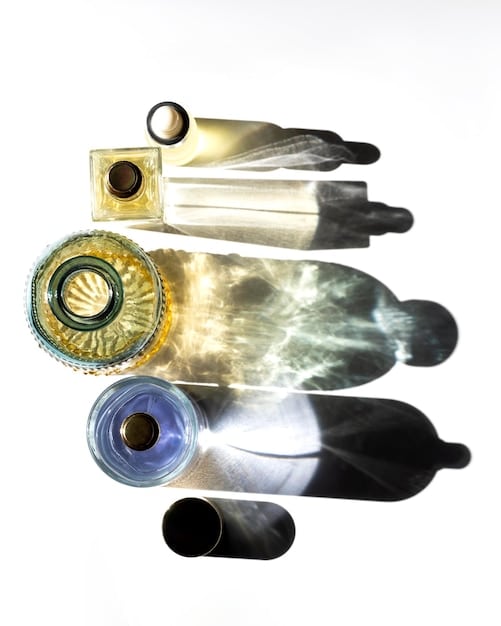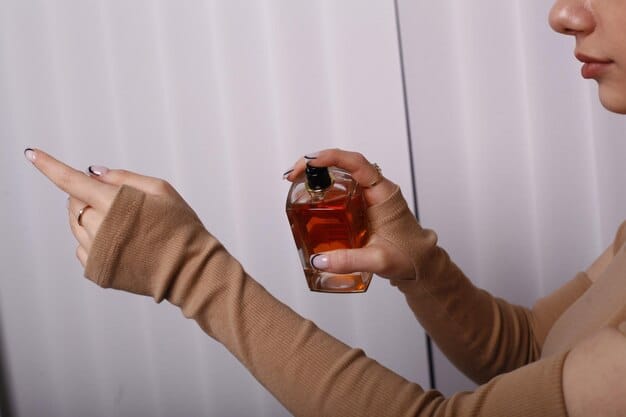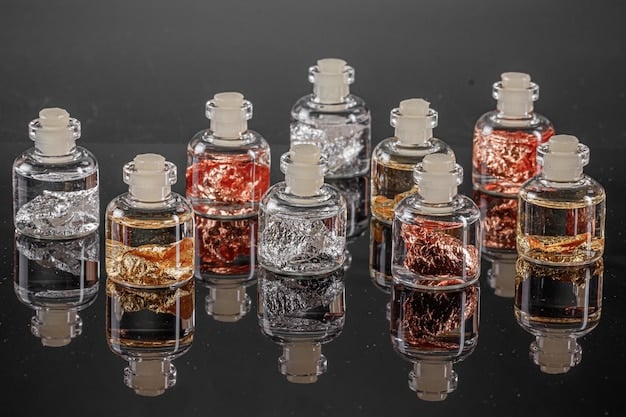Unlock Your Signature Scent: Expert Fragrance Layering Techniques

Fragrance layering is the art of combining multiple perfumes to create a unique and personalized scent, enhancing complexity and longevity, and allowing for individual expression through carefully selected complementary fragrances.
Have you ever wanted a scent that’s truly yours, something that no one else wears? Fragrance layering, the art of combining different perfumes, is the key to unlocking your personalized signature scent. It’s a fun, creative process that allows you to express yourself through fragrance.
The Basics of Fragrance Layering
Fragrance layering isn’t just about spraying on a bunch of perfumes at once; it’s a delicate art that requires understanding how different scents interact. By carefully selecting complementary scents, you can create a unique fragrance that evolves throughout the day.
Understanding fragrance families is key to successful layering. These families include floral, oriental, woody, and fresh. Knowing which families complement each other will allow you to create interesting and appealing combinations.
Understanding Fragrance Families
Before you start mixing scents, familiarize yourself with the different fragrance families. Each family has its own distinct characteristics.
- Floral: Typically feature notes of flowers like rose, jasmine, and lily. They’re often feminine and romantic.
- Oriental: These are warm and spicy, with notes like vanilla, cinnamon, and amber.
- Woody: As the name suggests, these scents feature notes of cedarwood, sandalwood, and vetiver. They’re often grounding and sophisticated.
- Fresh: These are clean and crisp, featuring notes like citrus, aquatic notes, and green herbs.
Keep these basic fragrance families in mind as you explore the art of layering. It’s better to start simple and experiment.
When first experimenting, choose a base fragrance that you love and understand its dominant notes. This will serve as the foundation for your layering endeavors.

Expert Techniques for Layering Perfumes
Layering fragrances is not about randomly spritzing different perfumes sequentially. It is a careful process, requiring an understanding of scent composition and application techniques. Expert techniques aim to maximize the complexity and longevity of the custom fragrance.
Proper application is just as important as scent selection. Start with lighter scents and layer heavier ones on top. Apply to pulse points for maximum diffusion.
Layering Order
Layering order matters. Apply the heaviest scent first, followed by lighter scents.
- Start with a base: A moisturizing lotion or body oil with a neutral or complementary scent can create a canvas for your fragrances.
- Apply the heaviest scent: This is usually a woody or oriental fragrance. Apply it to your pulse points.
- Layer lighter scents on top: A floral or fresh fragrance can add brightness and complexity.
- Less is more: Don’t overdo it. Start with a small amount of each fragrance and build up as needed.
Experiment with different combinations to find what works best for you. Consider the season and the occasion when choosing your scents.
Choosing Complementary Perfumes
The key to successful fragrance layering lies in selecting perfumes that complement each other. This often means choosing scents that share similar notes or belong to compatible fragrance families.
Consider scents that share a common note, such as vanilla or rose. Alternatively, explore combinations from different fragrance families that still work well together, like fresh and woody notes.
Scents That Play Well Together
Certain fragrance families naturally complement each other, creating harmonious and intriguing combinations.
- Floral and Fruity: A classic combination that’s both sweet and refreshing.
- Woody and Oriental: Creates a warm, sensual, and mysterious scent.
- Fresh and Citrus: Perfect for a clean, energizing fragrance.
Experimentation is Key
Don’t be afraid to experiment and try different combinations. Some unexpected pairings can lead to unique and beautiful scents. The process of discovery is at the heart of fragrance layering.
Sometimes, you may only need a fine mist of your chosen sprays. Focus on building up the layers gradually.

Creating Unique Scent Profiles
The ultimate goal of fragrance layering is to create a scent that is uniquely yours. This involves experimenting with different combinations and ratios of perfumes to find a blend that reflects your personal style and preferences.
Think about the occasions for which you’re creating your combined scent. A light, fresh blend for daytime wear may differ significantly from a richer, more complex blend for evening events.
Consider the Occasion
The occasion for which you’ll be wearing the fragrance should influence your layering choices.
- Daytime: Opt for lighter, fresher scents like citrus or floral.
- Evening: Choose richer, more sensual scents like oriental or woody.
- Special Occasions: Don’t be afraid to experiment with bold and unique combinations.
Document Your Experiments
Keep a record of your layering experiments. Note the fragrances you used, the ratios, and how the scent evolved over time. This will help you recreate successful combinations and avoid mistakes in the future.
Adjust your combinations until you arrive at your signature scent profile. Perfume layering is a path toward a scent that speaks to who you are.
Common Mistakes to Avoid
While fragrance layering can be a fun and rewarding experience, there are some common mistakes you should avoid. Overdoing it, choosing clashing scents, and neglecting the base are just a few examples.
Avoid spraying similar scents next to each other, or your combined scent may confuse the olfactory senses. Balance is important.
Overdoing It
One of the most common mistakes is using too much fragrance. Start with a small amount of each scent and build up as needed.
Choosing Clashing Scents
Not all scents are created equal. Some combinations simply don’t work well together. Avoid layering scents that clash or compete with each other.
Neglecting the Base
The base is the foundation of your fragrance layering. Neglecting to moisturize or using a scented lotion that clashes with your perfumes can ruin the entire effect.
With practice and patience, you will be able to avoid these mistakes and achieve complex, balanced scent profiles with expert-level fragrance layering.
The Longevity Factor
One of the often-overlooked benefits of fragrance layering is its impact on the longevity of the scent. By layering different perfumes with varying base notes, you can create a fragrance that evolves and lasts longer on the skin.
The base notes of any solid perfume should last longer on your skin, as these notes tend to linger. This is something to keep in mind when layering.
Base Notes are Key
Base notes are the foundation of any fragrance. These are the scents that linger on your skin for hours after the top notes have faded.
Layering for Longevity
To create a long-lasting fragrance, start with a base scent that features strong base notes. Then, layer on lighter scents with complementary top and middle notes.
Proper hydration improves the lifespan of layered scents, as does the amount of perfume that you spray. Consider testing and experimenting in small ways to maximize your benefit.
| Key Point | Brief Description |
|---|---|
| 💡 Scent Families | Floral, Oriental, Woody, and Fresh are combined. |
| ✨ Layering Order | Heaviest scent first; lighter scents on top. |
| 🧪 Complementary Scents | Choose scents with shared notes or families. |
| ⏱️ Longevity | Layer scents with varying base notes. |
FAQ
▼
Yes, fragrances with clashing notes can create unpleasant results when layered. The best approach is to test combinations on your skin, allowing the mixed scent to express its different dimensions. This process improves your scent layering outcomes.
▼
Ideal base scents include vanilla, sandalwood, or light musk. These provide a neutral but warm foundation. Choose a base that complements all of your individual sprays in your collection, for maximum flexibility and combinations.
▼
Spray each fragrance on separate blotter strips and hold them together. If you like the combined scent, try it on your skin. Wear this combination for the day, and monitor how the scent transforms and develops as it interacts with your skin chemistry.
▼
Yes fragrance layering can make your perfume last longer. Layering helps to anchor certain scent elements to the skin, creating a more complex profile. The end benefit is that you create a rich and multifaceted perfume which endures longer.
▼
Fragrance layering can be budget-friendly. Start with a few versatile fragrances that can be combined in many ways. This approach helps you to get the most mileage out of each of your scents and allows you to build your custom profile.
Conclusion
Mastering fragrance layering allows you to create a truly unique and personal scent. By understanding fragrance families, applying expert techniques, and avoiding common mistakes, you can craft a customized scent profile that reflects your individual style and lasts all day long.





